WDR Explained

WDR stands for Wide Dynamic Range (WDR). There could be situations when the CCTV could be subject to a wide range of light levels. For example: a CCTV mounted inside a building looking at the building entrance – daylight outside and ambient lighting inside. To compensate for this “wide range of lighting levels”, WDR is an awesome feature.
WDR is measured in dB. The decibel (dB) is a logarithmic unit used to express the ratio of two values – in this case the intensity of the ratio of the radiance of the brightest and least-brightest object in the scene. Since WDR is a logarithmic ratio, 1000:1 would be equivalent to a dB value of 60 dB. A higher WDR range (for example 140 dB), means that the CCTV can capture a greater scale of brightness. Some manufacturers implement DWDR. DWDR or Digital wide dynamic range is a software-based technique that enhances the image quality by adjusting the gamma value to brighten dark areas. True WDR is a sensor-based technology. A True WDR CCTV can produce images with an extremely wide dynamic range. The WDR image sensor can capture several images with short and long exposures, then combining them into a single frame. For all types of WDR, proper calibration of WDR levels is essential to achieve the optimum image quality.
BLC or Backlight compensation is different from WDR. BLC increases the level of exposure for the entire image, thereby making the object of interest clear but can cause overexposure in brightly lit areas. See example image below:
When comparing technical specifications from different CCTV manufacturers, it is important to understand that the dB unit is just an approximation of the capabilities of the CCTV. For the user, there is no way to verify the exact WDR levels. The best way to check the WDR levels is to verify it under required conditions.
WDR is measured in dB. The decibel (dB) is a logarithmic unit used to express the ratio of two values – in this case the intensity of the ratio of the radiance of the brightest and least-brightest object in the scene. Since WDR is a logarithmic ratio, 1000:1 would be equivalent to a dB value of 60 dB. A higher WDR range (for example 140 dB), means that the CCTV can capture a greater scale of brightness. Some manufacturers implement DWDR. DWDR or Digital wide dynamic range is a software-based technique that enhances the image quality by adjusting the gamma value to brighten dark areas. True WDR is a sensor-based technology. A True WDR CCTV can produce images with an extremely wide dynamic range. The WDR image sensor can capture several images with short and long exposures, then combining them into a single frame. For all types of WDR, proper calibration of WDR levels is essential to achieve the optimum image quality.
BLC or Backlight compensation is different from WDR. BLC increases the level of exposure for the entire image, thereby making the object of interest clear but can cause overexposure in brightly lit areas. See example image below:
When comparing technical specifications from different CCTV manufacturers, it is important to understand that the dB unit is just an approximation of the capabilities of the CCTV. For the user, there is no way to verify the exact WDR levels. The best way to check the WDR levels is to verify it under required conditions.



